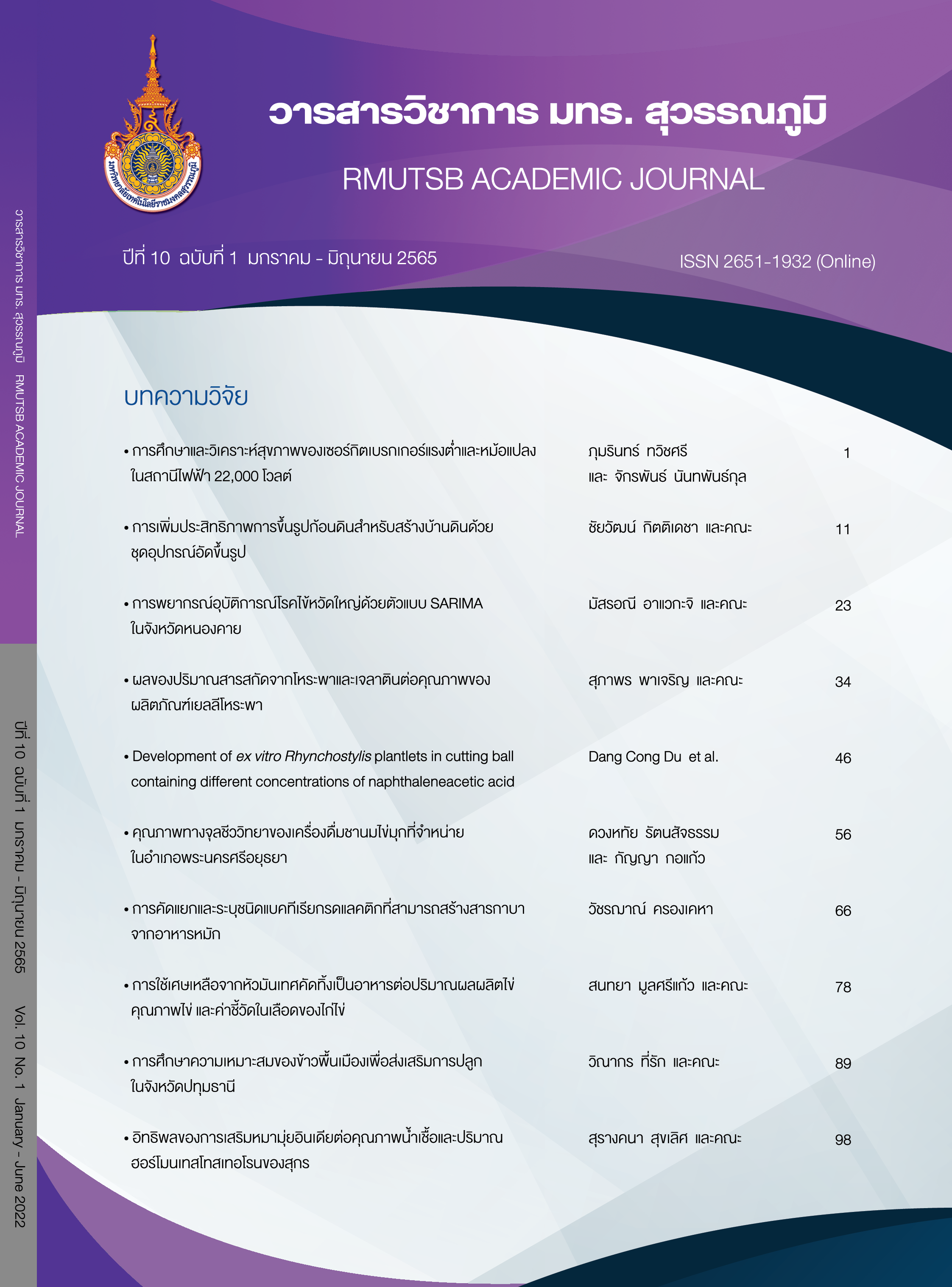Increasing productivity of clay brick forming to build a clay house using compressive forming equipment
Main Article Content
Abstract
Doi Pu Muen Community, Fang District, Chiang Mai Province, is located on the edge of Thailand where the electricity is produced from solar cells and hydropower. Building a clay house was developed and planed for staying and supporting the tourists. The process of clay lumps production with dimensions of 20 centimeters wide, 35 centimeters long, and 12 centimeters high is currently using the method of compacting the soil mixed with rice husks into the wood form, which takes an average of 150 seconds per lump. The average waiting time for drying the clay lumps is 30 days and the labor cost of 1.56 baht per lump which causes to delay of clay house construction problem. According to those problems, the researchers designed and built a compression molding kit that was able to increase molding efficiency with an average compression time of 84 seconds per lump, 44% reduction, using the average drying time of 18 days, or 40% reduction, labor cost 0.88 baht per piece or 44% reduction, the density and water absorption values were not much different. The analysis of the optimum soil mix ratio using the mixed experimental design technique. The soil ratio was 75% and the rice husk ratio was 25% or equal to 12 kg of soil weight, 4 kg of rice husk, using 3 kg of water for mix clay extrusion of one lump which was the appropriate ratio. Totally, the cost of compressive forming equipment was 13,500 baht while the benefit of investment is 136 baht per day, so that we can calculate the payback period of 3.30 months.
Article Details

This work is licensed under a Creative Commons Attribution-NonCommercial-NoDerivatives 4.0 International License.
Published manuscript are the rights of their original owners and RMUTSB Academic Journal. The manuscript content belongs to the authors' idea, it is not the opinion of the journal's committee and not the responsibility of Rajamangala University of Technology Suvarnabhumi
References
Baanjongguiang, A., Wattanachai, P., & Parichartpricha, R. (2016). The study of the rain washing resistance of external rubber-clay plaster of adobe walls under accelerated climate condition simulating. Academic Journal Uttaradit Rajabhat University, 11(2), 452-464. (in Thai)
Choowan, T. (2020). A study of the economic value of the paperless system in the company P.C. Takashima (Thailand) Co., Ltd. (Master’s thesis). National Institute of Development Administration, Bangkok. (in Thai)
Deepanya, W., & Suweero, K. (2019). Development of precast adobe wall panel with high corrosion resistance and good thermal insulation for energy and environmental conservation building. RMUTT Journal of Engineering, 17(1), 55-64. (in Thai)
Kamput, P. (2005). The introduction of earthen house (Part 1). RMUTT Journal of Engineering, 6, 29-50. (in Thai)
Keawploy, S. (2014). The optimization of developed formula for chicken ball mixed with domestic vegetables by design of experiment method. Proceeding of Rethink: Social Development for Sustainability in ASEAN Community (pp. 357-263). Khon Kaen: Khon Kaen Universiity. (in Thai)
Kererat, C., & Rungruang, S. (2019). Development of adobe bricks mixed with banana leaves fiber and coir as construction materials for earthen house. RMUTL Engineering Journal, 4(1), 8-15. (in Thai)
Laoakka, S. (2021). Wisdom of building a clay house for living in Maha Sarakham province. Journal of Cultural Approach, 22(42), 34-43. (in Thai)
Lertwattanaruk, P., & Tungsirisakul, J. (2007). Effect of natural materials o properties of adobe brick for earth construction. The Journal of Architectural/Planning Research and Studies, 5(1), 187-199. (in Thai)
Rodkour, P., & Kitchaijaruan, M. (2017). Formula development of Wapee (Clausena lansium (L.) Skeels) fruit leather product. Proceeding of Creative RMUT and Sustainable Innovation for Thailand 4.0 (pp. 47-51). Bangkok: Rajamangala University of Technology Rattanakosin. (in Thai)
Saouchai, T. (2014). The clay house: suitable attributes for construction and usage in Thailand. Sripatum review of science and technology, 6(1), 109-119. (in Thai)
Srisongkram, W., & Lueja, W. (2021). Semi-automatic bamboo-stripes machine for community handicraft. RMUTSB Academic Journal, 9(2), 237-249. (in Thai)
Surbkar, R., & Jarimopas, B. (1999). Development of sawdust-compressing machine for mushroom culture. Thai Agricultural Research Journal, 17(3), 268-275. (in Thai)
Ungbhakorn, V., & Thanadngarn, C. (2003). Machine design. Bangkok: Se-Education. (in Thai)
Virutchai, N. (2010). Research in curriculum and instruction. Bangkok: Sukhothai Thammathirat Open University. (in Thai)
Yimming, P., Trakoonyingcharoen, P., Sangkhasila, K., Inboonchuay, T., & Chungopast, S. (2016). The appropriate mixing of rice husk and sand with Saraburi series to make adobe brick for earth construction. Khon Kaen Agriculture Journal, 44(2), 321-326. (in Thai)
Yubolket, V., & Settheetham, D. (2017). Quality comparison of leaf-trash chunk-compressed fuel by compressor and hand. KKU Research Journal, 17(4), 85-96. (in Thai)


